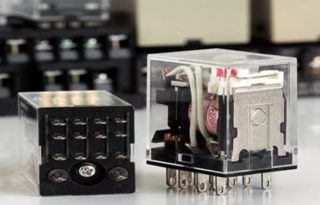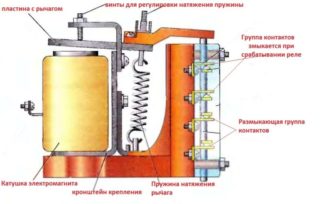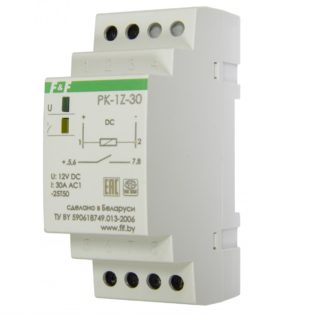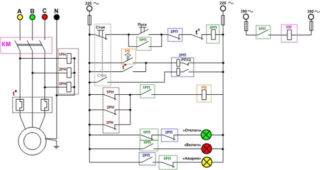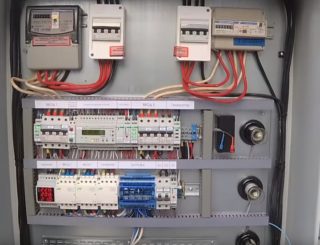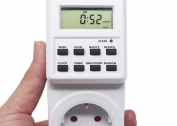An intermediate relay is a part of an electronic device used in electrical and electronic circuits for converting and amplifying electrical signals, opening and closing circuits. The device coordinates the work of blocks of equipment, individual elements, powerful devices. It is used in almost all industries and household appliances.
The purpose of the intermediate relay
This is an auxiliary device that is designed to control the action of various machines and complexes. It provides the operation of several electrical circuits at once, when it is necessary to carry out simultaneous switching of different contacts.
For example, one of the contacts should give an alarm on the relay screen, and the other should shut down. Or, with the help of one connection, the machine starts up, the other switches off another part of the device.
And also an intermediate relay (RP) is used to slow down the reaction at the required high loads. To control the main relay, which commutes large currents under high voltage conditions.
An intermediate relay is called because in the control circuit it is located between the pulse source that it controls and the power executive circuits.
RP device
The design of the device depends on the manufacturer and may vary according to the purpose. A standard device consists of the following units:
- core electromagnetic coil;
- magnetic circuit;
- spring mechanism;
- group of contacts.
The coil winding contains a large number of turns of insulated copper wire. Inside is a metal core, which is fixed by a L-shaped plate (yoke). A plate or anchor is installed above the coil. It is made of metal and is held by a return spring. Movable contacts are anchored. A pair of fixed contacts is located opposite. The core and coil together form an electromagnet. Parts such as the yoke, core, and anchor are components of the magnetic circuit.
RP can be designed for both direct and alternating current, with a voltage of 12 to 220 volts. Externally, the devices are no different. A DC device has a solid magnetic circuit. If it is composed of separate plates, the device is designed to operate with alternating current no higher than 10 amperes.
For ease of installation of the device, they use peculiar pads, which allows you to install an intermediate relay on 220V on a DIN rail. The device has openings for relay contacts, as well as contact screws to connect external conductors. Both input and output pins have the same numbering.
Types of intermediate relays
By design, they are divided into relay electromagnetic intermediate or mechanical and electronic devices. Mechanical relays can operate in different conditions. These are durable and reliable devices, but not accurate enough. Therefore, more often their analogs are mounted in a circuit - electronic relays on a din rail. Also, the relay can be installed on a flat surface. To do this, the lock tabs need to be moved apart.
According to the purpose of the device are divided into the following categories.
- Combined interdependent devices operating in a group.
- Logic devices that operate on microprocessors in a circuit with digital relays.
- Measuring, with a tuning mechanism, triggered at a certain signal level.
According to the method of operation, there are direct ones that directly open or close the circuit, and indirect ones that work together with other devices. They do not open the circuit immediately after an incoming signal.
There are devices of the maximum type of switching, when the operation occurs at the moment of increasing the threshold value of the circuit parameter. Minimum type triggers during performance degradation.
By the method of connecting to the circuit, there are primary ones that can be connected directly to the circuit. Secondary install through inductors or capacitors.
There is a group of protection relays, according to the principle of operation similar to intermediate ones. There are semiconductor devices, induction, polarization and electromagnetic. For example, a phase control device is a kv relay.
Principle of operation
The basis of functioning is the coordinated interaction of the magnetic flux of the coil and the moving armature, which is magnetized by this flux. The anchor is held by a spring and does not touch the core until voltage is applied to the winding.
When the current begins to flow, the magnetic field magnetizes the core. It attracts the anchor, forcing the spring tension. The movable contacts at the anchor move, closing or opening with the fixed contacts. After disconnecting the voltage, the current disappears, the core is demagnetized, the return spring returns the armature and contacts to their original position.
In relation to the purpose of the relay, the contacts can be normally open, normally closed and changeover. One device can have several groups of contacts at once. This design allows you to simultaneously control multiple electrical circuits.
Contacts are subject to special requirements. They should have good electrical conductivity, low transition resistance, without a tendency to weld, and also have great durability and a long service life.
Contacts are made from an alloy of hard and refractory metals, cermet compounds. More often they are made of silver. The material has low resistance, high electrical conductivity, good technological properties, moreover, it is relatively inexpensive.
In the diagrams, the relay coil is indicated in the form of a rectangle with the letter "K" and a serial number. Contacts are registered in the same letter, but with two digits. Of these, the first means the serial number of the relay, and the second - the number of the contact group to which it belongs. The numbers are written through the dot. Contacts are connected by a straight dashed line, if they are located nearby.
The contacts in the diagram are shown provided that the relay does not receive voltage. The layout and designation of the contact output is usually indicated by the manufacturer on the cover, which covers the working part of the device.
Application area
RP is found in almost all power, control, and protection circuits. Switching devices are used in substations, control rooms, boiler rooms. On the production line, the device can perform both simultaneously and sequentially several switching operations in the control or power circuits. RPs are widely used for computing, in telecommunications, controls, and other electronic devices.
In water supply and heating systems, when the depth pump is turned on, power is supplied to the coil. When the contacts are closed, the control system begins to work. The display shows voltage parameters, phase currents of the load, if necessary, temperature and other data, depending on the complexity of the circuit.
In the heating system, the relay acts as an amplifier for the control signal. The thermal sensor delivers a signal that turns on the RP.The contacts of the latter supply voltage to the winding, after which the contacts close. Thus, the power is connected to the heating element, boiler, boiler and other powerful heating devices.
Product Parameters
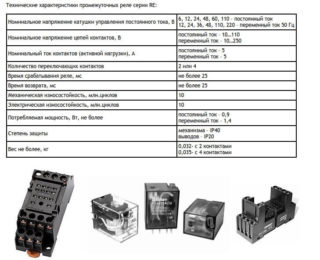 Different types of RPs have their own set of parameters with respect to technical characteristics. The need for certain data arises from the tasks presented to the device. The main characteristics responsible for the normal operation of the relay:
Different types of RPs have their own set of parameters with respect to technical characteristics. The need for certain data arises from the tasks presented to the device. The main characteristics responsible for the normal operation of the relay:
- sensitivity;
- current (voltage) operation, release, hold;
- safety factor;
- working current;
- winding resistance;
- switching ability;
- dimensions;
- electrical isolation.
It is necessary to know at what temperature and humidity operation of the device is possible, explosiveness of the working environment, permissible concentration of dust. These parameters are described in the technical specifications or in the instruction manual. The type of current and operating voltage are indicated on the winding of the device.
RP is an important and integral component of most chains in the energy sector. A variety of models indicates that such a switching device is capable of fully performing many functions in any circuit.
